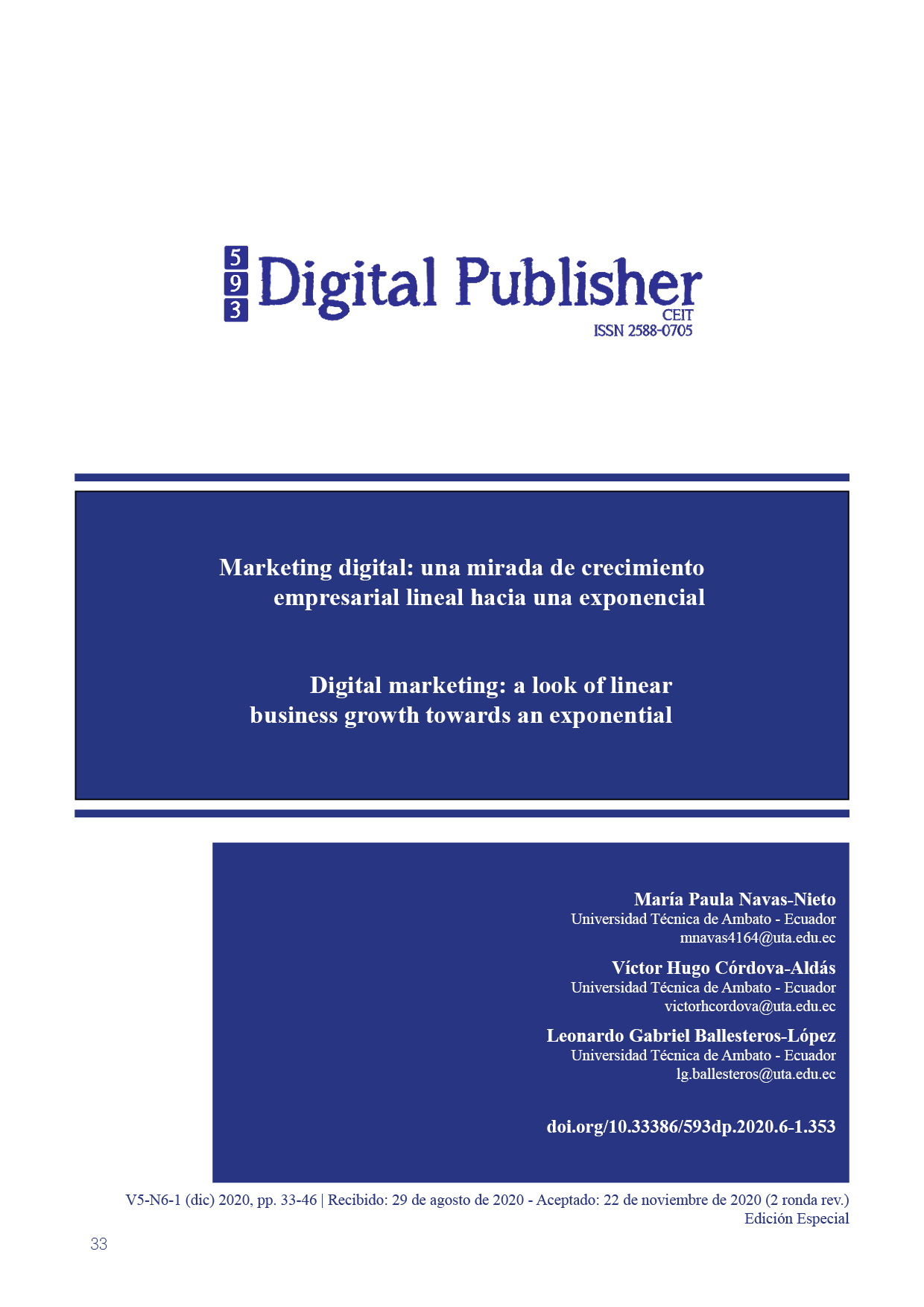Digital marketing: a look of linear business growth towards an exponential
Main Article Content
Abstract
From the fourth industrial revolution, new digital strategies emerge, applied in the new disruptive technologies that lead from a traditional organization to become an organization with exponential growth. The objective of the research is to determine and analyze the digital marketing strategies implemented for linear to exponential growth. The methodological design was of qualitative/quantitative type; qualitative, it was analyzed the five dimensions of an organization exponential and quantitative, it was validated by means of the combrach alpha the instrument a of the millennials with the object of investigation. The study sample was of two hundred and eight millennials from the city of Ambato. The scope of the study was correlational, because the hypothetical criteria of each dimension were detailed (purpose of massive transformation, community and crowd, algorithms, engagement and social technologies). It is concluded that the digital strategies in exponential organizations is the use of the Internet, Big Data-Marketing and Cloud Marketing.
Downloads
Article Details

This work is licensed under a Creative Commons Attribution-NonCommercial-ShareAlike 4.0 International License.
1. Derechos de autor
Las obras que se publican en 593 Digital Publisher CEIT están sujetas a los siguientes términos:
1.1. 593 Digital Publisher CEIT, conserva los derechos patrimoniales (copyright) de las obras publicadas, favorece y permite la reutilización de las mismas bajo la licencia Licencia Creative Commons 4.0 de Reconocimiento-NoComercial-CompartirIgual 4.0, por lo cual se pueden copiar, usar, difundir, transmitir y exponer públicamente, siempre que:
1.1.a. Se cite la autoría y fuente original de su publicación (revista, editorial, URL).
1.1.b. No se usen para fines comerciales u onerosos.
1.1.c. Se mencione la existencia y especificaciones de esta licencia de uso.
References
AppAnnie. (10 de Agosto de 2020). AppAnnie. Obtenido de https://www.appannie.com/apps/ios/top-chart/?country=EC&category=36&device=iphone&date=2020-08-10&feed=All&rank_sorting_type=rank&page_number=0&page_size=100&table_selections=
Ballesteros, L., Silva, F., Mena, D., & Mishell, A. (2019). Estrategias de Marketing Digital en Empresas E-Commerce: Un acercamiento a la perspectiva del consumidor. 593 digital publisher, 4(5-1), 108-122.
Boyd, D., & Ellison, N. (2008). Social Network Sites: Definition, History,and Scholarship. Journal of Computer-Mediated Communication(13), 210-230. Obtenido de https://onlinelibrary.wiley.com/doi/epdf/10.1111/j.1083-6101.2007.00393.x
Bricio, K., Calle, J., & Zambrano, M. (2018). El marketing digital como herramienta en el desempeño laboral en el entorno ecuatoriano: estudio de caso de los egresados de la Universidad de Guayaquil. Revista Científica de la Universidad de Cienfuegos, 10(4), 103-109.
Colvée, J. (2010). Estrategias de marketing digital para pymes. España: Anetcom.
Coomeva. (24 de Abril de 2018). Coomeva. Obtenido de https://www.coomeva.com.co/dirigencia/publicaciones/56027/cooperativas-empresas-lineales-o-exponenciales/
Del Alcazar, J. P. (Enero de 2020). Mentinno. Obtenido de Estado digital Ecuador 2020.
Diaz, E., Consuegra, D., & Talaya, E. (2008). Evaluación de la eficacia de las páginas web. Dialnet, 279-293. Obtenido de https://dialnet.unirioja.es/servlet/articulo?codigo=2751745
Echeverria, M. (Julio de 2015). Repositorio Universitat de Barcelona. Obtenido de http://diposit.ub.edu/dspace/bitstream/2445/66814/1/TFG-ADE-Ald%C3%A1miz-Maria-juliol15.pdf
Económica, E. (2017). Obtenido de https://enciclopediaeconomica.com/marketing-digital/
Enriquez, J., & Casas, S. (2013). Usabilidad en aplicaciones móviles. Dialnet, 25-47.
Gelb, A., Mital, N., & Mukjerjee, A. (2019). Hacia la gobernanza en tiempo real: el uso de la retroalimentación digital para mejorar servicios, voz y rendición de cuentas. Estado abierto, 4(1), 165-179.
Gondim, C., De castro, A., & Mendes, L. (2020). Empoderamiento psicológico de los anfitriones de airbnb. Dialnet, 29, 349-368. Obtenido de https://dialnet.unirioja.es/servlet/articulo?codigo=7316505
Google Trend. (10 de Agosto de 2020). Google Trend. Obtenido de https://trends.google.es/trends/explore?geo=EC&q=%2Fg%2F11f555cn8l,%2Fm%2F0glpjll,%2Fm%2F09jcvs
Goyzueta, S. (2015). Big Data Marketing: una aproximación. Scielo(35), 147-158. Obtenido de http://www.scielo.org.bo/pdf/rp/n35/n36_a07.pdf
Gretzel, U., & Hyan, K. (2013). Premises and promises of social media marketing in tourism. El Routledge Handbook of Tourism Marketing, 491-504. Obtenido de https://www.academia.edu/14261917/PREMISES_AND_PROMISES_OF_SOCIAL_MEDIA_MARKETING_IN_TOURISM_PREMISES_AND_PROMISES_OF_SOCIAL_MEDIA_MARKETING_IN_TOURISM
Growth Institute ESP. (24 de Febrero de 2019). Growth Institute ESP.
Guede, B., Cancino, C., & Lezana, B. (Enero de 2019). Repositorio Universidad de Chile. Obtenido de https://www.researchgate.net/publication/336286543_UNA_GENERACION_DE_EMPRESAS_UNICORNIO_EN_AMERICA_LATINA
Hernandez, D., & Leal, W. (2013). Percepción de riesgo y compras por internet. Dialnet, 20(2), 147-161. Obtenido de https://dialnet.unirioja.es/servlet/articulo?codigo=4696074
Insuasti, D., & Terán, V. (2020). Repositorio Universidad Técnica del Norte.
López, M. (9 de Junio de 2020). Contxto. Obtenido de https://contxto.com/en/news/top-tech-hubs-latin-america/
Madera, S. (20 de Enero de 2020). Latam List. Obtenido de https://latamlist.com/10-startups-you-never-knew-came-from-ecuador/
Martelanc, N. (03 de Enero de 2020). Repositorio Institucional Universitat Oberta de Catalunya. Obtenido de http://hdl.handle.net/10609/106846
Méndez, M. D. (2019). Repositorio Universidad de Burgos. Obtenido de Determinantes y consecuencias de la experiencia de cliente y la satisfacción en el ámbito digital: https://riubu.ubu.es/bitstream/handle/10259/5145/M%E9ndez_Aparicio.pdf;jsessionid=5A6538D379BF6B3C5521906657764826?sequence=1
Mieles, J., Albán, A., Valdospin, J., & Vera, D. (2018). E-commerce: un factor fundamental para el desarrollo empresarial en el ecuador. Revista Científica ECOCIENCIA, 1-17. Obtenido de http://ecociencia.ecotec.edu.ec/upload/php/files/diciembreespe/11.pdf
Molero, N. (05 de Febrero de 2018). Customer Centric Marketing, una estrategia para llegar al centro del corazón de los Millennials. Obtenido de Unir Revista: https://www.unir.net/marketing-comunicacion/revista/noticias/customer-centric-marketing-una-estrategia-para-llegar-al-centro-del-corazon-de-los-millennials/549203589688/
Obando, J., Serna, D., Ulloa, J., & Clavijo, N. (2019). Las Apps Móviles: Determinantes de hábitos de comidas rápidas. Revista espacios, 40(35), 20.
Otsuka, Y. (2015). Repositorio Universidad Inca Garcilaso de la Vega. Obtenido de http://repositorio.uigv.edu.pe/bitstream/handle/20.500.11818/344/T024_41295814_D.pdf?sequence=1&isAllowed=y
PanamericanWorld. (2020). Las startups que están prosperando en tiempos del coronavirus. PanamericanWorld. Obtenido de https://panamericanworld.com/revista/startups/las-startups-que-estan-prosperando-en-tiempos-del-coronavirus/
Pimiento, J. P. (14 de Agosto de 2013). Repositorio Universidad Industrial de Santander. Obtenido de http://tangara.uis.edu.co/biblioweb/tesis/2013/149867.pdf
Rodríguez, M., Fuenmayor, K., Patiño, Y., & Auxiliadora, M. (2017). Diseño de estrategias para una plataforma virtual. Revista I+D en TIC, 8(2), 21-28. Obtenido de https://revistas.unisimon.edu.co/index.php/identic/article/view/2950
Salim, I., Malone, M., & Van, Y. (2016). Organizaciones exponenciales. España: Bubok Publishing S.L.
Valencia, V., & Castillejo, G. (2011). La relación entre lealtad y satisfacción de clientes: el aporte del neuromarketing al debate. Revista Nacional de administración, 2(2), 51-60.
Vicepresidencia de la República Dominicana. (Agosto de 2017). IG Empowering People. Business & Communities. Obtenido de http://ctc.edu.do/wp-content/uploads/2018/01/MANUAL-MARKETING-DIGITAL.pdf




